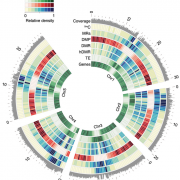Parallel evolution of flowering time in Capsella and Arabidopsis Just out in Genetics
Independent FLC Mutations as Causes of Flowering Time Variation in Arabidopsis thaliana and Capsella rubella.
Guo YL, Todesco M, Hagmann J, Das S, Weigel D.
Capsella rubella is an inbreeding annual forb closely related to Arabidopsis thaliana, a model species widely used for studying natural variation in adaptive traits such as flowering time. Although mutations in dozens of genes can affect flowering of A. thaliana in the laboratory, only a handful of such genes vary in natural populations. Chief among these are FRIGIDA (FRI) and FLOWERING LOCUS C (FLC). Common and rare FRI mutations along with rare FLC mutations explain a large fraction of flowering time variation in A. thaliana. Here we document flowering time under different conditions in 20 C. rubella accessions from across the species’ range. Similar to A. thaliana, vernalization, long photoperiods and elevated ambient temperature generally promote flowering. In this collection of C. rubella accessions, we did not find any obvious loss-of-function FRI alleles. Using mapping-by-sequencing with two strains that have contrasting flowering behaviors, we identified a splice-site mutation in FLC as the likely cause of early flowering in accession 1408. However, other similarly early C. rubella accessions did not share this mutation. We conclude that the genetic basis of flowering time variation in C. rubella is complex, despite this very young species having undergone an extreme genetic bottleneck when it split from C. grandiflora a few tens of thousands of years ago.



